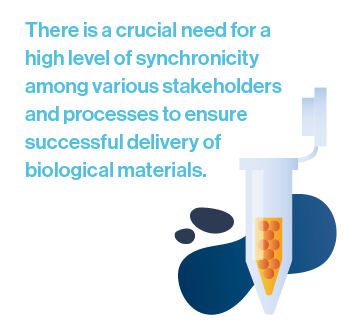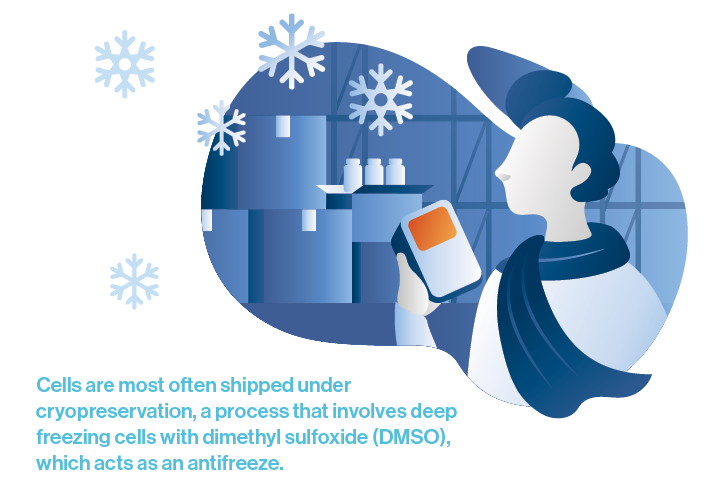December 6, 2019 PAP-Q4-19-NI-004
The Breakthrough Issue Feature: Part 3
The importance of these breakthrough medical approaches cannot be understated, and, as of September of 2019, the U.S. Food and Drug Administration (FDA) has approved a total of 17 gene and cellular therapy products2 aimed at treating a wide array of medical conditions, with that number expected to grow rapidly in the coming years. Although global research and clinical trials that utilize genetic and cellular therapeutic approaches abound, of paramount importance is seamlessly mitigating challenges associated with the supply chain of these biological materials. Maintaining the integrity and transparency of these autologous and allogeneic cells throughout extraction, storage, transportation, delivery and administration of surgical procedures can present a myriad of logistical challenges, requiring close and cooperative collaboration among industry, academic, regulatory, clinical and patient communities.
Before delving into the challenges associated with the gene and cell therapy supply chain, early considerations need to be evaluated and tested to determine the best methodology for cell delivery. A primary consideration is whether to deliver cells fresh or frozen, which often is determined by necessity rather than an understanding of how preservation impacts cell function.3 While freezing cells is commonplace for research purposes, clinical administration of gene and cell therapy requires a more specified and calculated approach to understanding the impact of preservation methods for their specific product, both in the short and long term, to better predict whether the cells will perform differently when fresh or frozen. This understanding is crucial early in the clinical research process to reduce bottlenecks that can delay approval and go-to-market viability. Another challenge is quality control — ensuring that there are sufficient surrogate markers of quality and/or function that are quick and easy to test.3 Compared with pharmaceutical products that are easily controlled, variability abounds in autologous therapies, specifically as it pertains to variables that exist within patients and donors, making it difficult to achieve consistency in processing. Methods need to be continually tested and improved to ensure the highest levels of quality control.
Medical technology companies are developing a range of packaging products that aim to preserve cells and maintain their integrity throughout transport and delivery. Cells are most often shipped under cryopreservation, a process that involves deep freezing cells with dimethyl sulfoxide (DMSO), which acts as an antifreeze.4 The DMSO inhibits the formation of ice crystals, which can cause cells to expand and become damaged. However, DMSO is toxic to cells and must be thoroughly washed out to prevent contamination. Once frozen, cryopreserved cells have traditionally been stored using either liquid nitrogen for aircraft travel or dry ice for ground transportation, which fall under passive (static) or semi-active packaging models. High-tech solutions are becoming more common, such as active (dynamic) packaging, which requires an external power source to maintain a constant temperature.5 In semi-active solutions, a static cold source, such as a phase-change material (PCM), is placed in an isolated compartment, and heat exchange between the biological material and the cold source is regulated using a system that operates without a power source.5 Passive packaging comprises eutectic plates of a PCM within an insulating material.5 All three of these approaches ultimately aim to provide environments for cells to maintain their viability throughout transport.
 Other Logistical Concerns Affecting Delivery and Use
Other Logistical Concerns Affecting Delivery and UseThere is a crucial need for a high level of synchronicity among various stakeholders and processes to ensure successful delivery of biological materials. Real-time monitoring and tracking of packages are necessary to ensure that they are handled properly, maintained at precise temperatures and successfully delivered to the correct destination at the right time. Providing transparent visibility during the shipping process is also crucial for maintaining a chain of custody and identity to establish accountability among all parties involved in the process. Other factors, including comprehensive understanding of local, national and international transport regulations, as well as the use of quality management systems, aid to increase the probability that cells are delivered on time and in usable condition.5
Upon arrival at their destination, cells need to be thawed and then require time to acclimatize and grow. Once fully thawed, an entirely different set of challenges emerges. Cells typically must be used within one to two hours, requiring surgeons, nurses and patients to coordinate very tight windows to execute the administration of treatment. Any delays in transportation can complicate or even terminate the viability of the cells, increasing costs required to restart the supply chain cycle. Another concern stems from the behavior of the cells post-thawing, as they may differ genetically and behaviorally as a result of the cryopreservation and shipping process.4

As more gene and cell therapy products gain U.S. FDA approval and their clinical administration becomes more common, manufacturers will have to decide how to best navigate challenges that arise from production from a centralized location. Due to the transportation sensitivities and limited shelf life of the cells themselves, the fastest route from laboratory to patient is most desirable. There are cases where it may be concluded that there are no viable routes to guarantee delivery of materials within an acceptable time frame. While this issue can theoretically be overcome by collecting patient samples sooner or requiring manufacturers to offer more flexibility in accepting or dispatching material to make it possible to align with available transportation schedules, a decentralized approach for collection and delivery may prove most sustainable as the industry grows and expands. Another possible solution is having patients travel to within closer proximity to manufacturing sites, but this approach is not as scalable or sustainable as decentralization, which should prove to become more feasible as the field continues to grow. Although the field is essentially still in its infancy, gene and cell therapy products offer hope to potentially billions of people around the globe. If the range of curable conditions through gene and cell therapy continues to increase, thereby creating higher patient demand, researchers, manufacturers, medical technology companies and medical practitioners will undoubtedly continue to collaborate to increase efficiency, consistency and quality control in the supply chain process.
“Gene and Cell Therapy FAQ’s. American Society of Gene & Cell Therapy.” Sep. 2019. Web.
“Approved Cellular and Gene Therapy Products.” U.S. Food and Drug Administration. Sep 2019. Web.
Coopman, Karen. “Logistical Considerations of the Cell Therapy Supply Chain at the Point of Care” Bioinsights. Jul. 2018. Web.
Brown, Alan. Industry Confronts Challenge of Shipping Cells for Therapy. Alliance of Advanced BioMedical Engineering. 16 Jan. 2018.
Jaffer, Gulam. Keys to Successful Storage, Management and Transport of Biological Materials. Pharma’s Almanac. 24 May 2019.

David is Scientific Editor in Chief of the Pharma’s Almanac content enterprise, responsible for directing and generating industry, scientific and research-based content, including client-owned strategic content, in addition to serving as Scientific Research Director for That's Nice. Before joining That’s Nice, David served as a scientific editor for the multidisciplinary scientific journal Annals of the New York Academy of Sciences. He received a B.A. in Biology from New York University in 1999 and a Ph.D. in Genetics and Development from Columbia University in 2008.